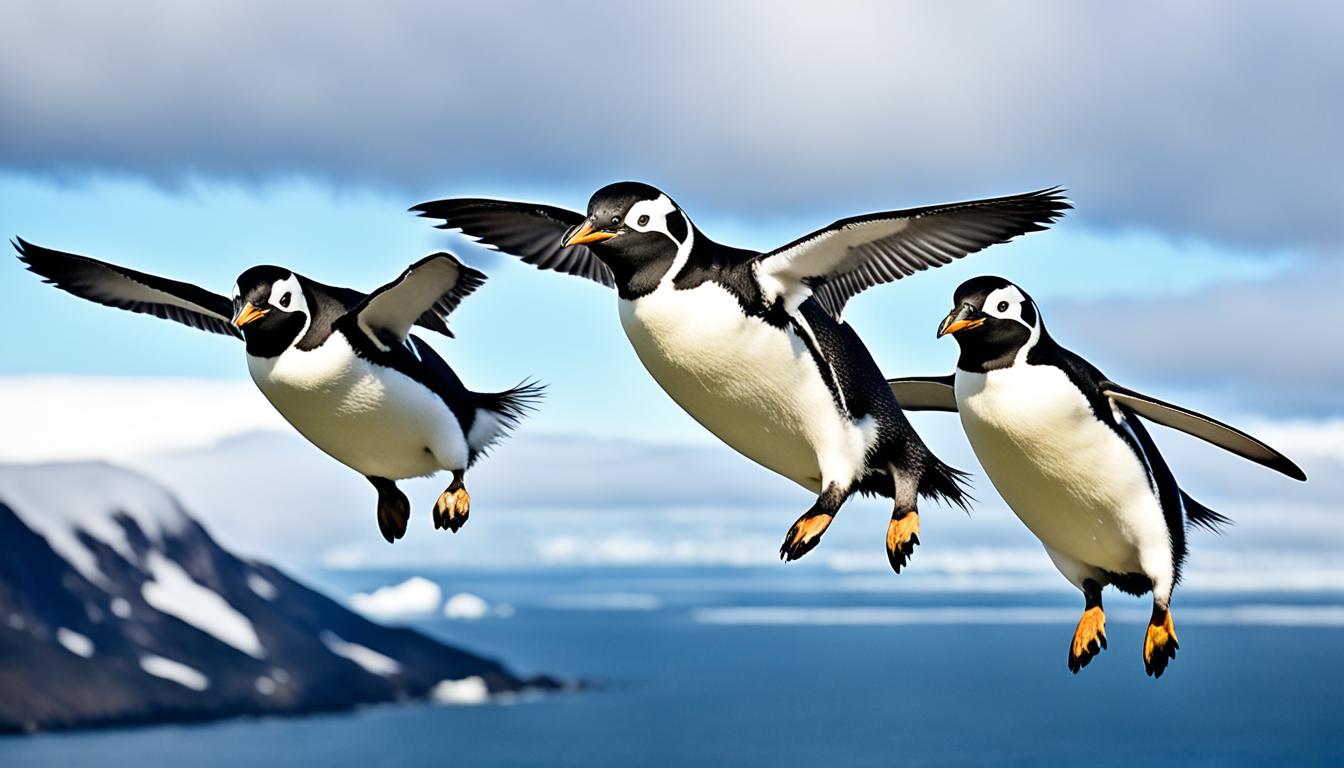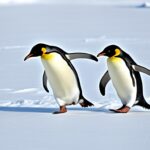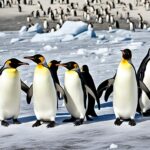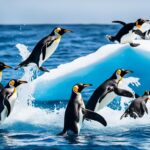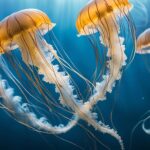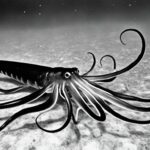Let’s dive into the world of penguins and ask: Can penguins fly? These birds are unique because they prefer swimming over flying. We’ll look into their penguin flight capabilities and see how evolution changed them for life in the water. Imagine their ancestors flying, which is quite different from today’s flightless penguins.
Aberdeen University researchers say penguins didn’t fly. Instead, they became experts in the ocean, with amazing diving skills. Let’s explore how penguins changed from flying birds to ocean masters.
The Evolution of Flightless Penguins
Penguins started from birds that could fly. Their evolution shows how they changed to be great swimmers. Over millions of years, they went from flying birds to swimming experts. This change was driven by their environment and their genes.
From Flying Ancestors to Aquatic Masters
The first penguin, Waimanu manneringi, shows us where it all began. As penguins evolved, they changed from flying birds to swimming ones. They changed their wings and body shape for swimming.
This made them better at moving underwater. It helped them hunt and dive well.
Significant Genetic Changes Over Millions of Years
Genetic changes were key to penguins’ evolution. Studies show that some genes changed to help them live in the sea. These changes affected their vision, diving skills, and how they stay warm.
Living in the water made penguins better at it. But it also meant they could no longer fly.
Can Penguins Fly?
Penguins have unique physical traits that help them thrive in the water. They are not like other birds that fly. Their wings are special, showing how they adapted to life in the sea.
The Adaptations That Led to Flightlessness
Penguins have wings that look different from those of flying birds. Over time, their wings changed into flippers. This change helped them swim better.
Key adaptations include:
- Body Shape: Streamlined bodies reduce drag while swimming, enhancing propulsion.
- Wing Structure: Short, stiff wings serve as flippers, aiding in swift, agile movement underwater.
- Muscle Development: Increased muscle strength around flippers supports powerful swimming strokes.
Studies show that flying and swimming can’t both be best at the same time. Penguins chose to be great swimmers. This is why they have special traits for the water.

| Adaptation | Function |
|---|---|
| Streamlined Body | Reduces water resistance |
| Flipper-like Wings | Enhances swimming capability |
| Strong Muscles | Improves propulsion and maneuverability |
Penguins have evolved to be amazing swimmers. They show how birds can adapt to different environments.
Penguin Flight Capabilities Explained
Understanding penguin flight capabilities means looking at why they can’t fly. These birds once flew with others, but changes made them great swimmers instead. This shows how penguins use their bodies for swimming.
Why Penguins Can’t Fly and Swim Efficiently
Penguins are amazing swimmers, diving deep into the ocean. They reach depths of up to 1,850 feet. Their wings turned into flippers, helping them move through the water. This lets them catch fish and krill easily, using less energy than flying would.
The Trade-offs in Wing Functionality
As penguins got better at swimming, their wings changed. These changes made them less agile on land. Now, they waddle or slide instead of flying. Here’s how their wings changed:
| Feature | Adaptation for Swimming | Impact on Flight |
|---|---|---|
| Wing Structure | Flippers for powerful strokes | Inability to achieve lift |
| Body Weight | Streamlined for reduced drag | Challenges with airborne maneuverability |
| Bone Density | Heavier bones for diving stability | Less buoyancy needed for flight |
Penguin Species and Their Unique Traits
There are 18 different penguin species, each with its own special traits. From the tiny Little Blue Penguin to the big Emperor Penguin, they show a wide range of sizes, colors, and feathers. These traits help them live in some of the toughest places on Earth.
Diversity Among Penguin Species
Every penguin species has unique adaptations for its home. The Gentoo Penguin has a strong body for fast swimming in icy waters. The Adelie Penguin is smaller and more agile, perfect for moving among ice floes.
These differences show how penguins evolved to survive in their environments. It’s a story of how their homes shaped their survival skills.
Physical Characteristics Influencing Flight Abilities
Penguins can’t fly, but they’re amazing swimmers. Their dense bones help them dive deep into the water. Their short, strong wings make them great swimmers, not flyers.
This shows how penguins traded flying skills for swimming abilities. They’re experts in the water, not the sky.
FAQ
Can penguins fly?
No, penguins cannot fly. They have changed over millions of years to be better at swimming. Their wings turned into flippers for diving and finding food.
What adaptations do penguins have for not flying?
Penguins changed a lot to improve their swimming. They got stronger flippers instead of wings. This helps them swim well but not fly.
Are there any penguin species with flying ability?
No, none of the penguin species can fly. Their flying ancestors changed into penguins. Now, they are made for life in the water, not the air.
What genetic changes helped penguins adapt to their environment?
Scientists found genes that help penguins see, dive, and stay warm. These changes let them live in the water better. They dive deep because of these changes.
How deep can penguins dive?
Some penguins dive as deep as 1,850 feet. Their wings turned into flippers help them dive deep.
Why did penguins lose their flying capabilities?
Penguins lost flying because it wasn’t as useful for them. Diving and finding food underwater was more efficient. So, they changed to live in the water.
How do penguins move on land?
Penguins move differently on land than in the water. They waddle or slide on their bellies to get around.
What variations exist among different penguin species?
There are 18 kinds of penguins. Each one is different in size, looks, and where they live. These differences affect how they swim and behave.

